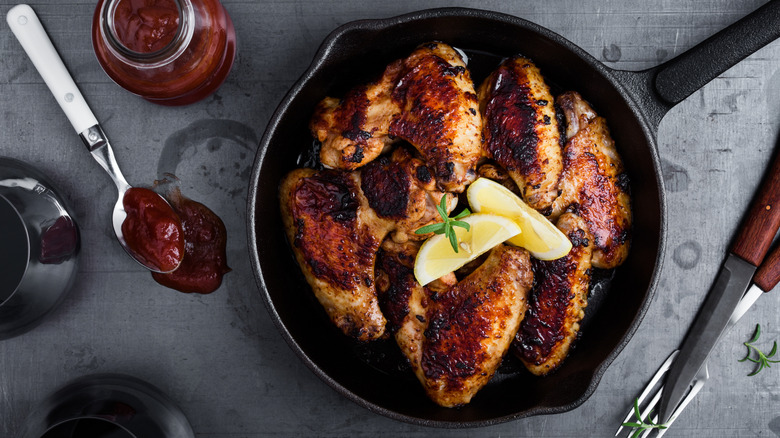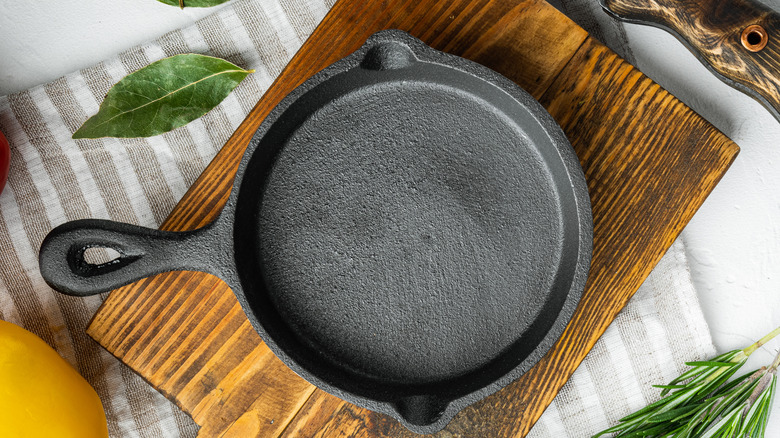You Just Thrifted A Cast Iron Pan. Now What?
Cast iron cookware is a must-have in every serious home chef's cookware lineup. From searing meats to baking bread to creating crunchy-on-the-edges-yet-soft-in-the-center desserts, these multi-use pans, Dutch ovens, and skillets add an unmistakable flavor and texture to favorite recipes. If you're lucky enough to thrift an older cast iron pan, it won't take much to make it ready to shine in your kitchen. You'll need to follow three steps: Check the pan for safety issues, remove old seasoning, and apply new seasoning.
First, make sure the new-to-you cast iron pan is safe to use. While a bit of rust on the pan itself isn't an issue, it's important to pay close attention to the handles (if your pan, skillet, or Dutch oven has any) to make sure they're sturdy and safe. You'll also want to make sure your pan is free of cracks.
It's a common cast iron myth that rusty skillets are a lost cause. Rust can be removed as you un-season an old cast iron pan. If you notice a red tinge to the iron that isn't rust, however, the pan might be beyond repair. This color change can indicate heat damage, and it can make it impossible to build up a solid layer of seasoning. If the handles are solid, your pan is crack-free, and it's black or rusty (not red) you're good to begin the cleaning and seasoning processes.
Removing old seasoning from your new-to-you cast iron pan
Seasoning — layers of oil that have built up over time to create a natural nonstick coating — is key to successful cast iron cooking. If you've thrifted a pan, you'll want to strip away old seasoning and start anew. There are a few different ways to do this: You can burn off old seasoning, use chemical methods to peel it off, or use electrolysis to remove both rust and old seasoning.
To burn off old seasoning, ensure that your pan is completely dry, then place it in your oven and run the self-clean cycle (if your oven requires that you remove metal racks before cleaning, place the pan on a preheated, bone-dry brick). Run the self-clean cycle, wait for the oven and pan to cool, then use steel wool or a wire brush to remove the now-ash old seasoning.
Lye can chemically remove old seasoning. However, you must be super careful with lye, as it can cause dangerous chemical burns if it touches your skin and pose a safety risk to children and pets. Purchase pure lye at a hardware store, and mix 1 pound with 5 gallons of water (for safety, always add lye to water, not the other way around). Let your pan sit in the solution for 24 hours, then scrub away the old seasoning.
Electrolysis can also strip away old seasoning, but many find this method to be cumbersome and not super effective. That being said, electrolysis will remove both rust and old seasoning at the same time, speeding up the process.
How to re-season an old cast iron pan
Now that you've put in some serious elbow grease to un-season your new-to-you cast iron pan, it's time to build up fresh seasoning that will create a beautiful nonstick surface, perfect for searing meats and creating crispy crusts. The concept of seasoning is simple: As oil heats on your pan, it bonds to the metal, and converts into a form of plastic. As you repeatedly season your pan over time, this layer will form a hard, nonstick coating (that's not greasy), making cooking normally sticky foods (like eggs) a joy.
To season your cast iron pan, new or old, start by washing it well with soap and water, then thoroughly dry it. Place it on a hot burner for a few minutes to ensure that all moisture has evaporated. Rub your favorite cooking oil all over your pan, inside and out, including the handle, with a kitchen cloth. Keep rubbing your pan until it doesn't look greasy anymore. Then, heat the pan upside down on a baking sheet or piece of foil in the preheated oven at 450 degrees Fahrenheit (this is well-regarded as the best temperature for seasoning a cast iron pan) for at least half an hour. Repeat this process three to four times, let the pan cool down, and you'll be ready to make your first cast iron creation (we recommend giving skillet cornbread a try).


